There are two forces that act on structures; compression and tension. Most buildings today are predominantly compression structures. Blocks or bricks are piled on top of one another to form walls, or else wood or metal are used to create frames for rigid materials to hang from and sit on top of.
There is another way to build, though, using flexible materials and the force of tension, rather than weight, to hold things together. Although Tensile Architecture is a fancy modern name for it, this is probably the oldest and simplest method human beings have devised to provide shelter. But not all tensile structures are buildings. Sailboats, balloons, and even early airplanes all play into the origins of tensile architecture.
Tents, Tipis, and Yurts
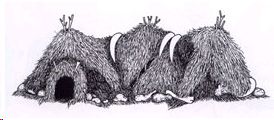 A tent is any supported structure covered by flexible material. Tents may not be as durable as conventional buildings, but they require far less material to create. This makes them more economical and portable. Tents arose where two conditions prevailed: a shortage of suitable building material and a need for mobility.
A tent is any supported structure covered by flexible material. Tents may not be as durable as conventional buildings, but they require far less material to create. This makes them more economical and portable. Tents arose where two conditions prevailed: a shortage of suitable building material and a need for mobility.
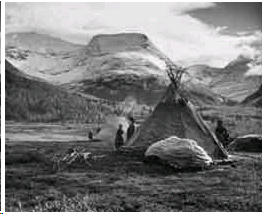 The oldest tents known come from Siberia, Lapland, Iceland and Alaska. To shield themselves from icy winds, nomadic hunters hung animal skins over large bones. If trees were available, branches were used as supports. Sometimes birch bark was used to cover the frame. Since these materials are completely biodegradable, it’s impossible to say just how human beings have been making tents. The evidence found thus far dates back at least 40,000 years. Thirty thousand years later, woven fabric was first incorporated into the tent.
The oldest tents known come from Siberia, Lapland, Iceland and Alaska. To shield themselves from icy winds, nomadic hunters hung animal skins over large bones. If trees were available, branches were used as supports. Sometimes birch bark was used to cover the frame. Since these materials are completely biodegradable, it’s impossible to say just how human beings have been making tents. The evidence found thus far dates back at least 40,000 years. Thirty thousand years later, woven fabric was first incorporated into the tent.
The ideal tent shape for shedding precipitation, withstanding extreme winds, and venting indoor fires is the cone. Cone-shaped tents are found throughout the Northern Hemisphere. Usually a “cone” of tree saplings were nested together to support a covering that sheltered the lower portion of the tent, leaving the top open to exhaust smoke.
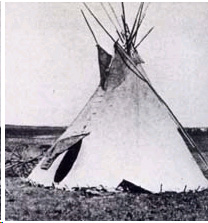 The American tipi is considered a masterpiece of structural design. Native Americans improved on the simple cone shaped tent by adding smoke flaps and a wall liner. The flaps, which can be turned to take advantage of the prevailing winds, serving as an adjustable vent. The liner forms a double wall with the outer covering, creating an insulative space and helps draw out the smoke from a fire. The liner is wedged to the ground while the outside covering is above the ground to create a convection current of cool outside air that travels behind the liner and draws the smoke up and out.
The American tipi is considered a masterpiece of structural design. Native Americans improved on the simple cone shaped tent by adding smoke flaps and a wall liner. The flaps, which can be turned to take advantage of the prevailing winds, serving as an adjustable vent. The liner forms a double wall with the outer covering, creating an insulative space and helps draw out the smoke from a fire. The liner is wedged to the ground while the outside covering is above the ground to create a convection current of cool outside air that travels behind the liner and draws the smoke up and out.
In the summer, the base of the outer wall is rolled up to allow cool air to enter. On windless or especially hot days, a small fire will actually increase the cooling effect for natural air conditioning. The native American ingenuity also extends to the support system. Tipi poles are shaved meticulously smooth, so that moisture that enters the smoke flap opening collects on them and runs down the poles to drain behind the liner.
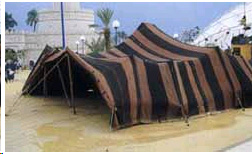 While Native Americans were perfecting the cone design, desert peoples such as the Bedouins, Berbers, Moors, and Kurds were developing the “black tents.” The black tent gets its name from the black goat hair used to weave its covering. This loosely woven cloth allows air to pass through while providing shade in hot and arid climates. Should this material get wet, however, its fibers will swell and repel rain.
While Native Americans were perfecting the cone design, desert peoples such as the Bedouins, Berbers, Moors, and Kurds were developing the “black tents.” The black tent gets its name from the black goat hair used to weave its covering. This loosely woven cloth allows air to pass through while providing shade in hot and arid climates. Should this material get wet, however, its fibers will swell and repel rain.
Black tents utilize all the features that to this day allow tensioned structures to function. The fabric is draped over ropes, which are supported in turn by a series of poles. The ropes carry the load to the stakes, which tension the structure and anchor it down.
 The ger (called a yurt in Russian) is among the most luxurious of the dwellings conceived by nomadic tribes. These shelters provide comfort and warmth in one of the highest and bleakest parts of the world; the Siberian steppe. The ger employs a circular lattice wall frame with a felted wool covering and a wooden door. A central opening in the roof allows the smoke from a cook stove to exit. Like the tipi, the ger is rich with religious symbolism; every part of it has symbolic significance.
The ger (called a yurt in Russian) is among the most luxurious of the dwellings conceived by nomadic tribes. These shelters provide comfort and warmth in one of the highest and bleakest parts of the world; the Siberian steppe. The ger employs a circular lattice wall frame with a felted wool covering and a wooden door. A central opening in the roof allows the smoke from a cook stove to exit. Like the tipi, the ger is rich with religious symbolism; every part of it has symbolic significance.
As people settled into agriculturally fixed communities, tents were assigned the role of providing shelter for religious events, social gatherings, and housing great armies. Most of these tents consisted of a central mast surrounded by a conical membrane or two masts and a steeply gabled roof.
 One of the most familiar 20th century tensile shelters is the circus tent. Early circus tents used a simple umbrella shape, however, they had the disadvantage of the central compression post being placed in the center of the performance space. By adding support poles, the center could be left free, and this led to the famous three ring circus. In their heyday around the turn of the century, these giant circus tents took up two acres and could hold over ten thousand people, enough for “the greatest show on earth”.
One of the most familiar 20th century tensile shelters is the circus tent. Early circus tents used a simple umbrella shape, however, they had the disadvantage of the central compression post being placed in the center of the performance space. By adding support poles, the center could be left free, and this led to the famous three ring circus. In their heyday around the turn of the century, these giant circus tents took up two acres and could hold over ten thousand people, enough for “the greatest show on earth”.
Sailing Ships
More than five thousand years ago, seafaring Mediterraneans found a way to harness the wind. And from that point on, the nautical sail has always incorporated the elements of tensile engineering, with pneumatic forms in the canvas, tension components in the rigging, and compressive support in the mast. By the nineteenth century, sailing ships had reached a remarkable level of sophistication in wind propulsion.
 The first major use of tensile principles in architecture came from transferring sailing technology. Roman coliseums and amphitheaters were frequently covered in retractable fabric roofs held up with masts and cables. And it was retired sailors who operated these complex canopies. The convertibility of these fabric roofs arose from their inability to construct a permanent roof capable of withstanding winds and heavy precipitation rather than a preference for opening up their amphitheaters.
The first major use of tensile principles in architecture came from transferring sailing technology. Roman coliseums and amphitheaters were frequently covered in retractable fabric roofs held up with masts and cables. And it was retired sailors who operated these complex canopies. The convertibility of these fabric roofs arose from their inability to construct a permanent roof capable of withstanding winds and heavy precipitation rather than a preference for opening up their amphitheaters.
Flying Machines
Tensile principles arrived on land not only by sea but by air as well. Like birds, aerial structures must be strong and lightweight. For this, tensile structures are ideal.
The Chinese developed elaborate tensile systems in the form of kites. The box kite, in fact, was the forerunner of the early airplanes. The Wright brothers used a series of fabric clad frames, strengthened by tension cables and separated by compression members. This allowed their plane to be both light enough and sturdy enough to take flight.
Bridges
 For 4,000 thousand years tensile principles have been used in bridge building as the only way to span large distances. Throughout the Far East and South America, suspension bridges made of rope and bamboo were used. Although bamboo is quite strong, it is not very durable. A more lasting solution came in 100 AD, when the Chinese invented wrought iron.
For 4,000 thousand years tensile principles have been used in bridge building as the only way to span large distances. Throughout the Far East and South America, suspension bridges made of rope and bamboo were used. Although bamboo is quite strong, it is not very durable. A more lasting solution came in 100 AD, when the Chinese invented wrought iron.
Some of the early bamboo bridges could span over 800 feet. It was not until the introduction of steel cable in the nineteenth century that western engineering could greatly increase that span. The inventor of steel cable was John Roebling who designed a number of suspension bridges in the United States. His masterpiece, the Brooklyn Bridge still remains one of the finest bridges ever built.
Modern Tensile Architecture
Despite all these precedents, tensile architecture never really took off until after WWII. Until then, no one had quite solved the dual problems of developing strong yet durable materials and reliably solving the complicated structural problems. A few isolated pioneers made valiant attempts, but with little success.
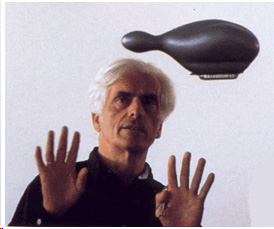 The late Frei Otto was the seminal figure in the development of tensile architecture. He was the first to lead away from the simple geometric solutions to the organic free forms that could respond to complex planning and structural requirements. The secret of Otto’s success lies in his study of the self-forming processes of soap bubbles, crystals, microscopic plants, animal life, and branching systems. He found that natural objects will create forms that are very efficient, wasting nothing and use a minimum of material.
The late Frei Otto was the seminal figure in the development of tensile architecture. He was the first to lead away from the simple geometric solutions to the organic free forms that could respond to complex planning and structural requirements. The secret of Otto’s success lies in his study of the self-forming processes of soap bubbles, crystals, microscopic plants, animal life, and branching systems. He found that natural objects will create forms that are very efficient, wasting nothing and use a minimum of material.
In the 1960’s, Otto founded The Institute for Lightweight Structures part of the University of Stuttgart in Germany. This innovative think tank published scores of books and papers packed with innovative ideas and trained a generation of European engineers. The future of lighter, more efficient, and adaptable structures had just begun.
Cable Net Structures
 Frei Otto’s first large-scale project was the sprawling 86,000 square foot German Pavilion for the Montreal Expo in 1967. At the time, there was no fabric strong enough to withstand the tension required for such a huge structure. Instead, Otto designed a network of interconnected cables to form the surface structure with a fabric membrane hung just below the cable net. It was the first structure to introduce the organic and free flowing shapes of tensile architecture.
Frei Otto’s first large-scale project was the sprawling 86,000 square foot German Pavilion for the Montreal Expo in 1967. At the time, there was no fabric strong enough to withstand the tension required for such a huge structure. Instead, Otto designed a network of interconnected cables to form the surface structure with a fabric membrane hung just below the cable net. It was the first structure to introduce the organic and free flowing shapes of tensile architecture.
Otto’s crowning achievement, however, was the stadium roof for the 1972 Olympic Games. This elegant cable net structure with acrylic panels covered over 40,000 square feet. It has been hailed as one of the greatest landmarks of the century.
Air Supported Structures
The Chinese developed the first hot air balloons from paper. In the eighteenth century, lightweight, close weave cotton fabric made the first passenger hot air balloons possible, and this led to the giant gas-filled airships and zeppelins of the early twentieth century. The development of synthetic fibers such as nylon and improved coating techniques led to a barrage of innovative balloon designs, and the appearance of the first pneumatic buildings during the Second World War.
 Although Frei Otto published exhaustive studies of the possibilities of utilizing air-supported structures, it was Walter Bird who put the ideas into practice. Walter Bird formed Birdair, which along with Geiger Berger designed and implemented several large air supported shelters. These low-pressure air-supported structures maintain a fabric membrane in tension by supporting it against the lower outside pressure. In this sort of structure, this difference in pressure can be quite small and internal occupants can safely breath the air.
Although Frei Otto published exhaustive studies of the possibilities of utilizing air-supported structures, it was Walter Bird who put the ideas into practice. Walter Bird formed Birdair, which along with Geiger Berger designed and implemented several large air supported shelters. These low-pressure air-supported structures maintain a fabric membrane in tension by supporting it against the lower outside pressure. In this sort of structure, this difference in pressure can be quite small and internal occupants can safely breath the air.
By giving the surface a low profile curvature and reinforcing the fabric with a grid of high strength cables, large spans could be achieved at a fraction of the cost and construction time required for conventional structures. However, their dependence on mechanical devices has proved problematic and has led to a number of disturbing deflations. Still, pressurized buildings led the way to a greater acceptance of fabric structures and opened the way for a new, less controversial structural system of tensile fabric architecture.
Tensioned Fabric Structures
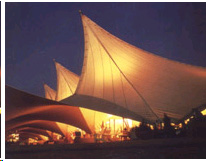 Tensile structures are one of the most promising trends in contemporary architecture. Once again, this era started in Germany in the 1950’s, when Frei Otto began building cotton fabric canopies using tent technology. Otto realized that structural and architectural forms are inseparable. He argued that flexibility is a strength, not a weakness. He proved that large tensile fabric buildings were possible, even though the materials and construction methods necessary were not yet available.
Tensile structures are one of the most promising trends in contemporary architecture. Once again, this era started in Germany in the 1950’s, when Frei Otto began building cotton fabric canopies using tent technology. Otto realized that structural and architectural forms are inseparable. He argued that flexibility is a strength, not a weakness. He proved that large tensile fabric buildings were possible, even though the materials and construction methods necessary were not yet available.
Today, tension membrane structures finally benefit from fabrics stronger than steel, with a guaranteed life span of over thirty years. These provide an elegant, energy efficient and economical solution where large open spans are required.
The second major challenge in tensile engineering was solved by Horst Berger, a civil engineer. Berger put Frei Otto’s theories into practice and is easily the one individual most responsible for the introduction of tensioned fabric structures into modern architecture. In 1974, Berger figured out how to mathematically describe and determine the shape of a 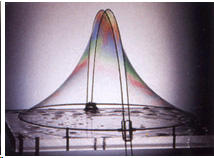 tensioned fabric structure. Until this breakthrough, tensile forms could be determined by painstakingly building models that could be dipped into a tank of soap.
tensioned fabric structure. Until this breakthrough, tensile forms could be determined by painstakingly building models that could be dipped into a tank of soap.
Given a fixed set of points, soap film naturally forms the ideal shape that will work for a tensile structure: the minimal surface area achievable between these points. The soap film model was photographed in front of a grid to be measured and then transferred into a pattern. Now a computer can do all the form finding and patterning.
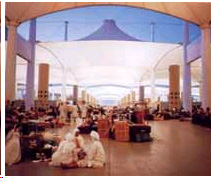 As if this achievement were not enough, Berger has also been responsible for some of the first, biggest and most beautiful tensile structures in the world. The largest to date is the Haj Terminal Building in Jeddah, Saudi Arabia. This massive structure accommodates over 700,000 pilgrims on their way to Mecca each year, all in the space of one month. Its 210 cone shaped canopies cover 105 acres and can shelter up to 100,000 people!
As if this achievement were not enough, Berger has also been responsible for some of the first, biggest and most beautiful tensile structures in the world. The largest to date is the Haj Terminal Building in Jeddah, Saudi Arabia. This massive structure accommodates over 700,000 pilgrims on their way to Mecca each year, all in the space of one month. Its 210 cone shaped canopies cover 105 acres and can shelter up to 100,000 people!
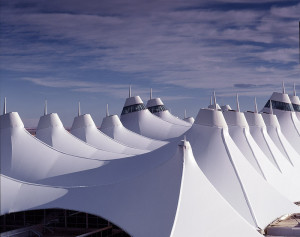 Berger also helped build the roof of the Great Hall at Denver International Airport. This tensile masterpiece is considered the test case for large tensioned fabric structures. Located in an area of significant snowfall, extreme winds and occasional severe hailstorms, its success has silenced any concerns about the suitability of tensile roofs in these conditions.
Berger also helped build the roof of the Great Hall at Denver International Airport. This tensile masterpiece is considered the test case for large tensioned fabric structures. Located in an area of significant snowfall, extreme winds and occasional severe hailstorms, its success has silenced any concerns about the suitability of tensile roofs in these conditions.
The first tensioned fabric roof in an extremely cold climate houses the Lindsey Park Aquatic Center in Calgary, Alberta. Built in 1983, this structure combines layers of teflon-coated fiberglass fabric with a translucent fiber wool filling. The membrane has an insulative value of R16 to R20 while still transmitting four percent of the available sunlight. This is enough to illuminate the entire facility in the daytime without the use of artificial light. It even allows for considerable indoor landscaping.
 Over the past several decades Tensile Structures have become more common and accepted. Red Sky Shelters is proud to have completed out first major civic tensile structure and canopy over the Pack Square stage in the very center of downtown Asheville NC. For years after the renovation of Asheville’s central park the stage sat uncovered due to a lack of funds. After three more years of fundraising and planning we were finally able to complete this project in 2014.
Over the past several decades Tensile Structures have become more common and accepted. Red Sky Shelters is proud to have completed out first major civic tensile structure and canopy over the Pack Square stage in the very center of downtown Asheville NC. For years after the renovation of Asheville’s central park the stage sat uncovered due to a lack of funds. After three more years of fundraising and planning we were finally able to complete this project in 2014.
Bibliography
Berger, Horst: Light Structures-Structures of Light: the Art and Engineering of Tensile Architecture. (1996) Basel; Boston; Berlin: Birkhauser.
Hatton, E.M.: The Tent Book (1979) Houghton Mifflin Company: Boston. Comprehensive history of tents from ancient to modern. Includes a now dated tent buyers guide.
Otto, Frei (editor): Tensile Structures (1962) The MIT Press: Cambridge and London. Two volume classic put out by the Institute for Lightweight Structures (now out of print) illustrating thousands of innovative ideas.

